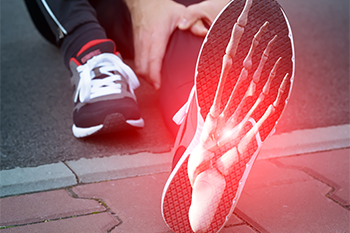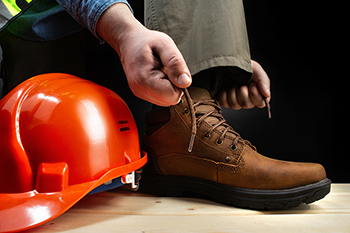Items filtered by date: November 2021
Choosing the Right Shoes for Toddlers
 It’s important to know that shoes for toddlers and shoes for older children are not the same. The final foot bone is only beginning to form at about 3 years of age, and feet will not be fully developed until the teen years. It’s wise to choose shoes for toddlers that offer proper support, and make sure the child’s feet are accurately measured in both length and width. Although the shoes should be lightweight, they also should have a sturdy, flat sole. Because a small child’s foot grows so rapidly, it is suggested to replace shoes every three months to ensure they fit correctly. Seeing a podiatrist for information on the best shoes for your baby is recommended.
It’s important to know that shoes for toddlers and shoes for older children are not the same. The final foot bone is only beginning to form at about 3 years of age, and feet will not be fully developed until the teen years. It’s wise to choose shoes for toddlers that offer proper support, and make sure the child’s feet are accurately measured in both length and width. Although the shoes should be lightweight, they also should have a sturdy, flat sole. Because a small child’s foot grows so rapidly, it is suggested to replace shoes every three months to ensure they fit correctly. Seeing a podiatrist for information on the best shoes for your baby is recommended.
Making sure that your children maintain good foot health is very important as they grow. If you have any questions, contact one of our podiatrists of Barry University Foot and Ankle Institute. Our doctors can provide the care you need to keep you pain-free and on your feet.
Keeping Children's Feet Healthy
Having healthy feet during childhood can help prevent medical problems later in life, namely in the back and legs. As children grow, their feet require different types of care. Here are some things to consider...
Although babies do not walk yet, it is still very important to take care of their feet.
Avoid putting tight shoes or socks on his or her feet.
Allow the baby to stretch and kick his or her feet to feel comfortable.
As a toddler, kids are now on the move and begin to develop differently. At this age, toddlers are getting a feel for walking, so don’t be alarmed if your toddler is unsteady or ‘walks funny’.
As your child gets older, it is important to teach them how to take care of their feet.
Show them proper hygiene to prevent infections such as fungus.
Be watchful for any pain or injury.
Have all injuries checked by a doctor as soon as possible.
Comfortable, protective shoes should always be worn, especially at play.
If you have any questions please feel free to contact our offices located in Miami, North Miami Beach, Miami Beach, and Tamarac, FL . We offer the newest diagnostic and treatment technologies for all your foot and ankle needs.
Are You Wearing the Right Size Shoe?
 One of the most important factors for keeping the feet healthy and free of issues is wearing shoes that are the right size. Because your feet can shift in your shoe while standing, make sure there is approximately half an inch between the end of the big toe and the start of the shoe while sitting. It is also important to try on the shoes with the same pair of socks that you intend to wear them with, and shop for shoes in the afternoon so you can get a better idea of the fit, since the feet expand throughout the day. Lastly, if you find a pair of shoes that are perfect, but are slightly too big, wearing insoles with them may help the shoe fit better. If you have any other questions in regards to the importance of making sure your shoes fit correctly, don’t hesitate to reach out to a podiatrist.
One of the most important factors for keeping the feet healthy and free of issues is wearing shoes that are the right size. Because your feet can shift in your shoe while standing, make sure there is approximately half an inch between the end of the big toe and the start of the shoe while sitting. It is also important to try on the shoes with the same pair of socks that you intend to wear them with, and shop for shoes in the afternoon so you can get a better idea of the fit, since the feet expand throughout the day. Lastly, if you find a pair of shoes that are perfect, but are slightly too big, wearing insoles with them may help the shoe fit better. If you have any other questions in regards to the importance of making sure your shoes fit correctly, don’t hesitate to reach out to a podiatrist.
Finding a properly-fitting shoe is important in reducing injuries and preventing foot problems. For more information about treatment, contact one of our podiatrists from Barry University Foot and Ankle Institute. Our doctors will treat your foot and ankle needs.
Proper Shoe Fitting
A common concern when it comes to foot health, having properly fitted shoes can help prevent injuries to the foot. Out feet affect our posture and gait, which in turn affects the biomechanics and overall bodily structure. With 33 joints, 26 bones, and over 100 ligaments, the potential for serious injury is much greater than one realizes. Although the feet cease growth in adulthood, they still change shape as they mature. Here are some factors to consider when it comes to investing in proper fitting shoes:
- Be sure the shoes fit correctly right away
- Ensure the ball of your foot fits comfortably in the widest portion of the shoes
- Even though they may look fashionable, improper fitting shoes can either create adverse conditions or exacerbate existing ones you may already have
- Walk along a carpeted surface to ensure the shoes comfortably fit during normal activity
Keeping in mind how shoes fit the biomechanics of your body, properly-fitting shoes are vitally important. Fortunately, it is not difficult to acquire footwear that fits correctly. Be sure to wear shoes that support the overall structure of your body. Do your feet a favor and invest in several pairs of well-fitted shoes today.
If you have any questions please feel free to contact our offices located in Miami, North Miami Beach, Miami Beach, and Tamarac, FL . We offer the newest diagnostic and treatment technologies for all your foot and ankle needs.
What to Do After a Stress Fracture
The long metatarsal bones of the foot connect the ankle to the toes. Excessive running, jumping, dancing, or other repetitive activities can cause hairline fractures in these bones, causing a condition known as a stress fracture. This is different from an acute break, caused by a fall or other sudden or traumatic injury. Stress fractures can also be the result of osteoporosis, or thinning of bones, arthritis, or nerve damage due to diabetes. Some ways to ease the pain include resting the foot, keeping it elevated, using a walker or crutches, and taking over-the-counter pain medication. You can return to normal activities when pain is no longer present. However, stress fractures can last from four to six weeks. If pain worsens or persists, please consult a podiatrist for further treatment.
Activities where too much pressure is put on the feet can cause stress fractures. To learn more, contact one of our podiatrists from Barry University Foot and Ankle Institute. Our doctors can provide the care you need to keep your pain free and on your feet.
Dealing with Stress Fractures of the Foot and Ankle
Stress fractures occur in the foot and ankle when muscles in these areas weaken from too much or too little use. The feet and ankles then lose support when walking or running from the impact of the ground. Since there is no protection, the bones receive the full impact of each step. Stress on the feet can cause cracks to form in the bones, thus creating stress fractures.
What Are Stress Fractures?
Stress fractures occur frequently in individuals whose daily activities cause great impact on the feet and ankles. Stress factors are most common among:
- Runners
- People affected with Osteoporosis
- Tennis or basketball players
- Gymnasts
- High impact workouts
Symptoms
Pain from the fractures occur in the area of the fractures and can be constant or intermittent. It will often cause sharp or dull pain with swelling and tenderness. Engaging in any kind of activity which involves high impact will aggravate pain.
If you have any questions please feel free to contact our offices located in Miami, North Miami Beach, Miami Beach, and Tamarac, FL . We offer the newest diagnostic and treatment technologies for all your foot and ankle needs.
Giving Your Feet a Break While Standing at Work
If you are one of the many Americans who have to stand all day at work, you may be looking for ways to reduce the strain and pressure your feet and legs have to endure on the job. One of the simplest things you can do is change your position throughout the day. Engage your core and make conscious adjustments to your posture periodically to shift body weight. Find shoes that feel great and support your heels and arches. Custom orthotics created by your podiatrist can further address your specific foot structure and help distribute weight more evenly across your feet. Check with your podiatrist about other techniques to alleviate foot stress while you are on the job and on your feet.
While working on the feet, it is important to take the proper care of them. For more information about working on your feet, contact one of our podiatrists from Barry University Foot and Ankle Institute. Our doctors will treat your foot and ankle needs.
Working on Your Feet
Standing on your feet for long periods of time can cause stress and pain in your feet. Your whole body may experience change in terms of posture, back pain, bunions, callouses and or plantar warts. There are ways to avoid these conditions with proper foot care, smart choices and correct posture.
Positive Changes
Negative heeled shoe – Choosing this shoe type places the heel slightly lower than the ball of the foot. These are great for overall foot health. Find shoes that fit you correctly.
Go barefoot – Our feet were not designed to be enclosed for all hours of the day. Try to periodically expose your feet to air.
Eliminate Pain
Foot Exercises – Performing simple exercises, incorporating yoga and doing stretches are beneficial. This will allow increased blood flow to the area and muscles of the foot.
Achilles tendon – Stretching the foot out flat on the floor will relax the calf muscles and tendon. These exercises can be performed almost anywhere. Make sure you add these exercises to your daily regimen.
With a little bit of this information and knowing more about foot health, you will notice changes. Foot stretches and proper footwear will help with pain and prevent further issues.
If you have any questions please feel free to contact our offices located in Miami, North Miami Beach, Miami Beach, and Tamarac, FL . We offer the newest diagnostic and treatment technologies for all your foot and ankle needs.
What Is Causing a Burning Sensation in the Ball of My Foot?
Morton’s Neuroma is a non-cancerous enlargement commonly found in the nerve between the 3rd and 4th toes, however it may also occur between the 2nd and 3rd toes. Morton’s Neuroma is a leading cause of burning pain and inflammation in the ball of the foot (metatarsalgia). People with Morton’s neuroma often feel like they are walking on a pebble and can even experience shooting pain or tingling in the affected toes. Wearing high heels/tight shoes is often associated with Morton’s neuroma, as well as participating in high-impact sports which can stress the nerves between toes repeatedly. Having certain foot deformities such as bunions, hammertoes, flat feet, or high arches may also put you at risk for developing Morton’s neuroma as these conditions may pressurize and compress nerves between toes. If you have any pain in the ball of your foot, make an appointment with a podiatrist who will be able to make a proper diagnosis and offer appropriate treatment methods.
Morton’s neuroma is a very uncomfortable condition to live with. If you think you have Morton’s neuroma, contact one of our podiatrists of Barry University Foot and Ankle Institute. Our doctors will attend to all of your foot care needs and answer any of your related questions.
Morton’s Neuroma
Morton's neuroma is a painful foot condition that commonly affects the areas between the second and third or third and fourth toe, although other areas of the foot are also susceptible. Morton’s neuroma is caused by an inflamed nerve in the foot that is being squeezed and aggravated by surrounding bones.
What Increases the Chances of Having Morton’s Neuroma?
- Ill-fitting high heels or shoes that add pressure to the toe or foot
- Jogging, running or any sport that involves constant impact to the foot
- Flat feet, bunions, and any other foot deformities
Morton’s neuroma is a very treatable condition. Orthotics and shoe inserts can often be used to alleviate the pain on the forefront of the feet. In more severe cases, corticosteroids can also be prescribed. In order to figure out the best treatment for your neuroma, it’s recommended to seek the care of a podiatrist who can diagnose your condition and provide different treatment options.
If you have any questions, please feel free to contact our offices located in Miami, North Miami Beach, Miami Beach, and Tamarac, FL . We offer the newest diagnostic and treatment technologies for all your foot care needs.



